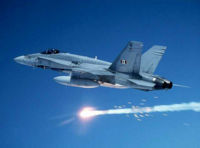CF-18 Hornet
The CF-18 is a multipurpose, high-performance twin-engine fighter that can equally well handle air-to-air (air defence, air superiority, combat air patrol, etc.) or ground-attack (close air support, battlefield air interdiction, etc.) roles, aided by on-board computer systems that can be quickly re-programmed to the mission at hand.
The Hornet’s primary roles include air defence, training, tactical support, and air superiority. It has supported missions in both NORAD and NATO. Other roles also include aerobatic demonstration and aerospace test and evaluation.
The CF-18 Hornets are located at 3 Wing Bagotville, Que and 4 Wing Cold Lake, Alta.
Modernization
The CF-18 Incremental Modernization Project, launched in 2001, is an eight-year project, divided into two phases, that will result in a total of 80 CF-18 Hornets (62 single-seat and 18 dual-seat aircraft) being significantly upgraded in their radios, avionics and weapons systems as well as in the structural integrity of their fuselages, wings, and tail sections. The IMP is based on a U.S. Navy Engineering Change Proposal (ECP 583), which defines how the USN/USMC are upgrading and extending the service life of their F/A-18s. Total costs for the Incremental Modernization Project are not yet confirmed, but are estimated to be at least $1.9 billion (Cdn). Including various other CF-18-fleet enhancements that are not officially part of the IMP, total spending on upgrading the lifespan and operational effectiveness of the Hornet fleet will come in at about $2.6 billion.
Phase 1
Phase I of the IMP is occurring between 2002 and 2006, and involves the procurement and installation of a new on-board radar system; “Have Quick” jam-resistant radios that are compatible with technology employed by NATO-ally air forces; a combined interrogator/transponder unit to ensure that CF-18s are recognized as “friendlies” when spotted on allied radar scopes during combat operations; a stores management system for weapon-system and associated-equipment control; new mission-designation computers; and embedded Global Positioning System/Inertial Navigation System (GPS/INS) capability.
(The first completed “Phase I” CF-18 was delivered back to Air Command in May 2003, and by mid-December 2004 a total of 40 CF-18s had completed the Phase I upgrade.)
Separate from the IMP, but being acquired in the same timeframe are a new infrared sensor; a multipurpose instrument-panel display group; a night vision imaging system; advanced air-to-air and air-to-ground weapons; a landing-gear “get well” program to reduce corrosion and improve gear retraction; and an Advanced Distributed Combat Training System.
Phase 2
Phase II of the IMP is scheduled to begin in 2006 and conclude in 2009.It involves the installation of a data-link system for information-exchange connectivity with similar systems on other surveillance and air-combat platforms; a helmet-mounted display; a crash-survivable flight recorder; and an upgraded electronic warfare (EW) suite to enhance survivability against future surface-to-air threats.
Again, not officially part of the IMP, but related to upgrading the CF-18’s capabilities are these other projects: a fuselage Centre Barrel Replacement Project (for 40 of the upgraded aircraft); an Air Combat Manoeuvring Instrumentation System; an Integrated Electronic Warfare Support Station; and the Electronic Warfare Test Equipment Project.
Collectively, the abovementioned initiatives will ensure that Canada has a state-of-the-art CF-18 fighter force that remains effective and operationally credible until the 2017-20 timeframe.
